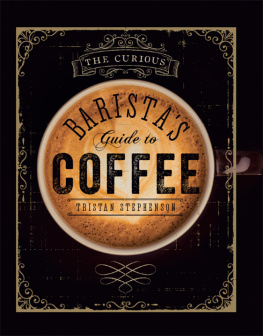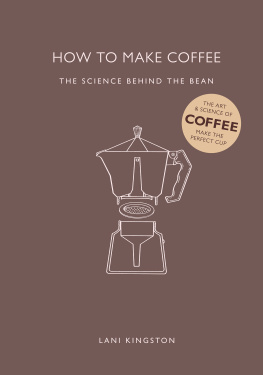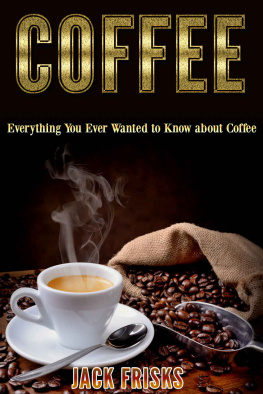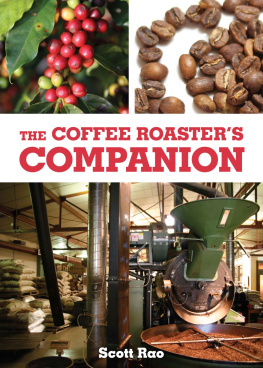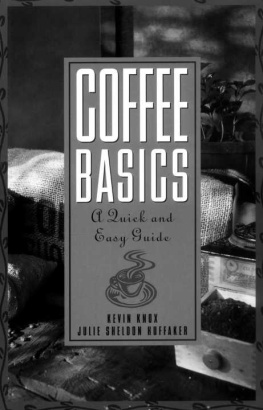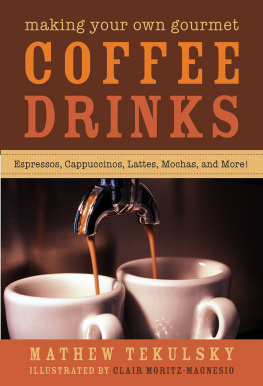THE CURIOUS
BARISTAS
Guide to
COFFEE


THE CURIOUS
BARISTAS
Guide to
COFFEE
TRISTAN STEPHENSON
WITH PHOTOGRAPHY BY ADDIE CHINN


Designer Geoff Borin
Commissioning Editor Nathan Joyce
Production Manager Gordana Simakovic
Art Director Leslie Harrington
Editorial Director Julia Charles
Publisher Cindy Richards
Prop Stylist Sarianne Plaisant
Indexer Vanessa Bird
First published in 2015 by
Ryland Peters & Small
2021 Jockeys Fields
London WC1R 4BW
and
341 East 116th Street
New York, NY 10029
www.rylandpeters.com
10 9 8 7 6 5 4 3 2 1
Text Tristan Stephenson 2015
Design and commissioned photographs
Ryland Peters & Small 2015
See page 192 for full photographic credits.
The authors moral rights have been asserted. All rights reserved. No part of this publication may be reproduced, stored in a retrieval system or transmitted in any form or by any means, electronic, mechanical, photocopying or otherwise, without the prior permission of the publisher.
e-ISBN: 978-1-84975-908-3
ISBN: 978-1-84975-563-4
A CIP record for this book is available from the British Library.
US Library of Congress CIP data has been applied for.
Printed in China
Note: the metric system is often favoured by coffee enthusiasts because it is more accurate when it comes to precision measurement, but imperial measurements are also provided in this book. Purchasing a set of digital scales is recommended to ensure accuracy.

CONTENTS
For a lot of people, a cup of coffee need only be something of passable quality and sufficient heat that delivers the expected caffeine kick. The daily grind of life becomes a more evenly matched contest when theres a mug of coffee at your side or a paper cup of it in your hand. I cant deny that Ive enjoyed the energizing effects of caffeine, and its certainly questionable whether this book would have been completed without it!
The adoption of Italian espresso culture over the past 60 years has awarded the humble cup of joe with a refreshing new makeover, transforming coffee into something evocative, aspirational and sexy, while at the same time asking even the most macho of men to embrace fashionable Continental terms like macchiato. The espresso bar has, in turn, paved the way for the rise of the now ubiquitous American style chain-caf which, these days, stands as a cultural middle ground between home and work, relaxation and concentration, comfort and functionality oh, and they sell coffee, too.
We are now seeing a new wave of qualityfocused coffee shops that aim to pique our curiosity and satisfy our desire for a delicious drink, and, for a growing number of people, a good coffee is becoming much more than a simple agent of stimulation. We are beginning to recognize that coffee can contain a wealth of appreciable and sometimes unexpected flavours, but also that those who make good coffee are worthy of the same degree of recognition that any other complex culinary field would warrant. These baristas carry an air of quiet erudition about them as the new breed of coffee shop aspires to engage its customers in earnest dialogue over such things as coffee origin, roast style and brewing method.
The plethora of flavours and aromas that a cup of coffee can offer has, in turn, inspired us to dig deeper, and we are beginning to discover the fact that a great cup of coffee has a story behind it, too. The history of coffees ascent to prominence is part of that, but also the physical journey of a cup of coffee and the concerted efforts of numerous people across various parts of the world. Recognizing the fragility of this journey, coupled with the occasional glimpses of liquid perfection as every element comes together, is what makes some of these moments exploring coffee very special indeed.
We live in a time where our raw and roasted coffee has never tasted better, and the individuals who are driving its quality and success forward have never been more empowered. The coffee trade is more transparent than ever and delicious speciality coffee is easily obtainable. This book explores how coffee has reached this stage of development, the processes that it takes to get to us, why it tastes the way it does, and the considerations and practices that go into brewing amazing coffee drinks.
HOW TO USE THIS BOOK
The first section of this book documents coffees extraordinary history. Its fair to say that coffee has influenced the world we live in, having played its part in politics, economics, philosophy and technology for over 500 years and continuing to fuel the thoughts of the great thinkers of the modern era. Books like this one only exist as a result of the things that have come before, and when writing this book I found myself taking time out from all the scientific geekery of brewing delicious drinks, and grounding myself in a piece of history from coffees turbulent past.
The next chunk of the book covers all things concerning the production of coffee. This takes us from tropical farms, through to the processing of coffee cherries and on to the multifarious art of coffee roasting. All the stages of coffee production are necessary practical steps towards creating a physical cup of coffee, but within that they each harbour idiosyncrasies in the form of practices or methods, derived either from trial and error or tradition, which through scientific understanding can now be manipulated and exploited to great effect. Each of these factors combines and culminates in the coffee that youre sipping on now, whether its a sad and lifeless cup of instant or the finest speciality coffee brewed to perfection. In this section, I also endeavour to explore some of the science of coffee flavour, while looking into such things as caffeine, water and the physics and chemistry of extracting flavour from ground coffee.

The following part of the book is about grinding and brewing (the latter is split into three chapters: espresso, espresso-based drinks and other brewing methods). We start with the different grind sizes and the impact on the resulting cup of coffee. From there, we move on to the vast array of brewing paraphernalia available to the modern barista, each unique in its approach towards separating brewed coffee from spent coffee grounds, and each unique in its ability to cast light on the numerous contours of coffees character.
The final section in the main part of the book includes a range of coffee-based drinks that I have developed over the years. Some are original creations, and others are based on food and drink that you are very likely familiar with albeit with a twist. These recipes are diverse, but the one thing that they have in common is the celebration of coffee flavour.
At the rear of the book, Ive included an appendix, split into two parts. The first is an exploration of 40 coffee-producing countries, with a concise description of their respective histories, the size of their operations and the style and quality of some of their most exciting coffees. The second part focuses on a dozen different varieties of coffee, along with their respective features and merits. Just like grapes in wine, specific varieties produce a range of different-looking coffee beans that go on to produce quite different-tasting cups of coffee.

